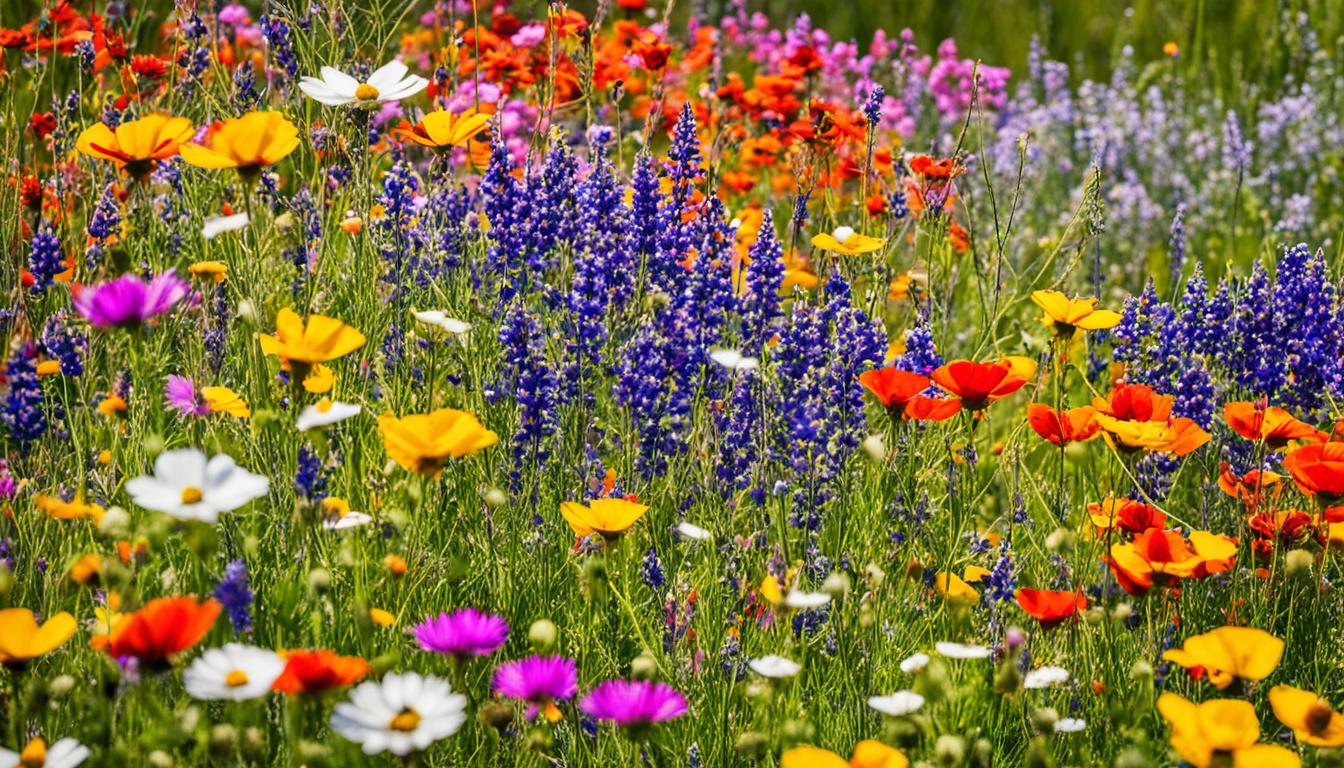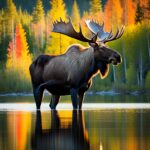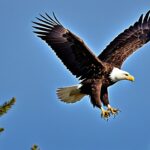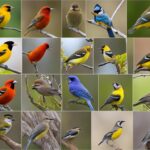Ever thought that just planting wildflowers could really help our bees? Many think tossing a few seeds does the trick, but it’s not that simple. While wildflowers offer good nectar and pollen, bees mostly gather from trees and bushes. To truly help bees with our gardens, we should understand this bigger picture.
Simply planting wildflowers won’t do all the work. Wildflower fields need careful tending to keep up their mix of plants. Without the right care, these places might not help bees as much as we hope. So, what’s the best way to use wildflowers to attract bees? Let’s explore that next.
Introduction to Bee-Friendly Wildflowers
Wildflowers are key in helping bees thrive. They offer bees important resources when other plants can’t. These resources are pollen and nectar, essential for bees and the honey they make. Adding wildflowers to your garden can make a big difference for bees.
Importance of Wildflowers for Bees
Wildflowers are a big help for bees, providing food year-round. They ensure bees have something to eat when other sources are gone. By keeping the food flowing, wildflowers support bee colonies and their well-being.
General Characteristics of Bee-Attracting Wildflowers
Bee-friendly wildflowers share special traits. They include:
- Easy-to-Land Petals: Flat or open flowers are great for bees to land on.
- Tubular or Bell-Like Shapes: These shapes help bees feed on nectar easily.
- Bright Colors: Bees love bright blues and yellows.
- Pleasant Scents: Smelly flowers attract more bees and pollinators.
Planting these wildflowers makes your garden more eco-friendly. They support bees and make your space more beautiful. Adding these flowers is good for your local environment.
Bird’s Foot Trefoil: A Summer Pollinator Delight
Bird’s Foot Trefoil is a top choice for bees in the summer. It’s loved for its bright yellow flowers and how easy it is to grow. This makes it great for adding to gardens that attract bees.
Flowering Season and Characteristics
This plant blooms from early to mid-summer, catching everyone’s eye. With its pea-family traits, Bird’s Foot Trefoil has clustered bright yellow flowers. They look like a bird’s foot, which is why it’s named as such. These plants do well in various soils and need little care, perfect for summer pollinators.
Benefits for Bees and Other Pollinators
Bird’s Foot Trefoil is a treasure for bees and other bugs. It serves as a rich source of nectar and pollen, aiding various bee types. Besides honeybees, this plant’s pretty flowers bring in butterflies and helpful insects. This helps it shine among plants that draw in bees.
Wild Blackberry Bushes for Late Spring Bees
Wild Blackberry Bushes are key in late spring for bees. They bloom from late spring to early summer. Bees find plenty of nectar and pollen on these bushes.
Flowering and Pollination Cycle
In late spring, wild blackberries start to bloom. Bees visit each flower to pollinate. Pollination turns flowers into tasty blackberries, which we and wildlife enjoy.
Additional Wildlife Benefits
Wild blackberries are not just for bees. They also help various wildlife. Birds and small animals eat the berries. Even insects find them helpful. This helps keep the environment diverse and healthy.
| Benefit | Bees | Wildlife |
|---|---|---|
| Food Source | Yes – Pollen & Nectar | Yes – Fruits |
| Biodiversity Support | Highly Supports | Enhances Habitat |
| Season | Late Spring | Late Spring to Early Summer |
The Role of Dandelions in Early Season Bee Forage
Dandelions are key in providing food for bees early in the year. They bloom first in the spring, giving bees food they need after winter. This is vital for bees coming out of their winter sleep.
With their bright yellow petals, dandelions stand out. They also produce lots of pollen. This is important because other flowers might not be around yet.
Flowering Time and Pollen Production
In early spring, from March to April, dandelions start to flower. They keep blooming until autumn. This long season means bees have food for a while. Dandelions are known for their large amounts of pollen. So, they are crucial for bee health.
Importance of Dandelions in Spring
At the start of the year, not many flowers are blooming. This means there’s not much food for pollinators. Dandelions step in to offer bees a steady food source. Their role in spring is especially critical for bees. It affects their energy and well-being. Having lots of dandelions supports early bee food and helps keep gardens diverse.
Best Wildflowers for Bee Habitats: Daisies
Looking to make your garden more bee-friendly? Daisies are a great choice. They grow well in many places and provide lots of food for bees. You can pick from different types, like the common lawn Daisy or the bold Ox-Eye. Daisies will really stand out in any garden that’s good for bees.
Daisies look pretty in your garden and help bees a lot. Bees love their simple, open flowers. These flowers are full of pollen and nectar. Bees can easily get what they need from daisies. This is important, especially in places where there aren’t many other flowers around.
When you’re planting for bees, variety matters. There are many types and colors of daisies, so you can choose what you like. Look for daisies that bloom at different times. Some good choices are the Shasta Daisy and the English Daisy. They keep bees fed all year round.
A garden full of daisies can really help bees in your area. By planting different daisies, you can feed bees all the time. This way, you’re helping bees and making your garden more beautiful and full of life.
Nurturing Bees with Dog Rose Wildflowers
The Dog Rose is perfect for creating spaces where bees thrive. This rose blooms with many simple summer flowers, which bees love for their sweet nectar. Bees not only find food but also help in keeping the area’s nature diverse.

The Dog Rose offers food even after the flowers are gone. Its rose hips are full of nutrients and are great for birds and other animals. This makes it key in keeping an area good for bees.
Adding Dog Rose to your garden means choosing a plant that’s easy to care for. These wild climbing roses for bees are very strong, making them great for all gardeners. By growing Dog Rose, you help build a place where bees and nature can do well together.
Viper’s Bugloss: All-Day Nectar Source
Viper’s Bugloss is known for giving nectar all day long. It’s a key part of the summer nectar sources. The plant’s blue spires look beautiful and are continuous nectar plants for bees.
Most flowers only give nectar at midday. But Viper’s Bugloss gives nectar from sunup to sundown. This makes your garden very welcoming to bees. Adding Viper’s Bugloss means bees have nectar all day, boosting their activity.
So, why should you add Viper’s Bugloss to your garden?
- Extended Flowering Season: It blooms well into summer, extending the blooming time.
- Consistent Nectar Supply: Bees always find nectar in Viper’s Bugloss, day or night.
- Attractive Bloom: Its bright blue flowers make the garden look good. They also attract bees with their color.
Viper’s Bugloss is vital for summer nectar needs. It keeps nectar flowing, helping bees stay healthy. Adding it to your garden supports a lively bee community in summer.
Growing and Supporting White Clover for Bees
White Clover is crucial for farming and making honey. For a long time, it’s been in bee gardens, offering bees a steady supply of honey. Beekeepers in England especially love it for helping make honey.
Historical Significance of Clover
In the past, clover was important for bees and was even grown to make money. Because there was so much of it, bees could find nectar easily. This kept bees healthy and strong.
Modern Role in Bee-Friendly Gardens
Today, many people use White Clover in their bee gardens to help bees. It blooms all summer, providing bees with lots of food. Adding this plant to your garden supports a long history of helping bees and shows you care about the environment.
| Aspect | Details |
|---|---|
| Historical Use | Clover as a historic honey source, relied upon by English beekeepers |
| Modern Application | Essential addition to bee gardens and pollinator-friendly spaces |
| Blooming Period | Throughout the summer season |
| Benefits | Provides sustainable nectar and supports bee populations |
Creating a Pollinator Habitat with Foxglove
Foxglove is a standout plant known scientifically as Digitalis purpurea. It is a biennial wildflower with tall, elongated stems and clusters of tubular blooms.
Bees love foxglove because it offers plenty of nectar and pollen. Adding foxglove to your garden makes it more appealing to buzzing pollinators. This ensures your garden is lively and beautiful.
Characteristics of Foxglove
Foxgloves are loved by bees for many reasons. They take two years to complete their life cycle. In their second year, they bloom a lot.
These plants have bell-shaped flowers in various colors like pink, purple, white, and yellow. Bees find it easy to land on them. They also hold lots of nectar for the bees to enjoy. Foxgloves add drama and function to any garden because of their height and dense flower spikes.
Benefits for Bees and Gardeners
Foxgloves are a favorite of bees for their nectar. They are crucial when other food sources are low. Planting them helps support bee populations and biodiversity.
For gardeners, foxgloves are easy to care for. They do well in sunlight or partial shade. They bring elegance and height to garden beds. This makes them perfect for anyone wanting to create a bee-friendly space.
FAQ
What types of wildflowers attract bees in the USA?
Some popular bee-friendly wildflowers in the USA are Bird’s Foot Trefoil, Wild Blackberry Bushes, and more. These plants give both pollen and nectar, which bees need. They are great for bee gardens and helping bee populations.
Why are wildflowers important for bees?
Wildflowers are key for the bees’ ecosystem, giving them food when other options are scarce. They help bees survive and promote biodiversity. This makes them vital for any place wanting to be a good habitat for bees.
What are the general characteristics of bee-attracting wildflowers?
Wildflowers bees love often have flat petals or bell shapes in bright colors. They smell good too. These traits make them easy for bees to spot and enjoy.
When does Bird’s Foot Trefoil bloom, and what are its benefits?
Bird’s Foot Trefoil blooms in summer, giving bees pollen and nectar. Its yellow flowers in clusters are great for bees and other pollinators. It’s an important plant in the bee world.
How do Wild Blackberry Bushes benefit bees during late spring?
In late spring, Wild Blackberry Bushes are a big food source for honeybees. They help with fruit-making too, which feeds other animals. This makes them key in late spring for bees.
What role do Dandelions play in early-season bee forage?
Dandelions are a key food early in the season with their yellow flowers. They are vital when other flowers aren’t around yet. This shows their critical role for bees early on.
Why are Daisies good for bee habitats?
Daisies, like the lawn Daisy and Ox-Eye, provide a lot of food for bees. They can grow in many places and bloom a lot. This makes them great for attracting bees.
How does Dog Rose support bee populations?
Dog Rose blooms a lot in the summer, attracting bees with its simple flowers. It also feeds birds. This makes it good for biodiversity and a nice place for bees.
What makes Viper’s Bugloss a unique nectar source?
Viper’s Bugloss gives nectar all day, unlike many flowers that stop after noon. Its blue spikes in summer are always open for bees. This makes it special as a food source.
What is the historical significance of White Clover and its modern role in bee gardens?
White Clover was big in English honey long ago and is still important today. It blooms all summer, feeding many pollinators. Its past and present value in bee gardens show how crucial it is.
How does Foxglove benefit bees and gardeners?
Foxglove is loved by bees with its tall stems and many flowers. It helps make good spots for pollinators and beautifies gardens. This makes it great for bees and the people that love them.







